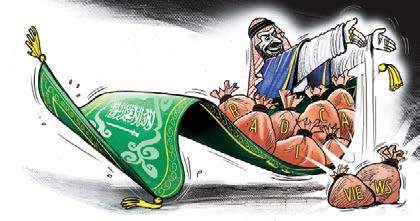
The Islamic ummah (supranational community) is bewildered and so is the rest of the world following the shocking swirl of events in Saudi Arabia during the last few weeks. With Crown Prince Mohammed bin Salman in command, the Islamic nation has arrested over 200 people—princes, ministers, top officials and billionaires, among them Prince Alwaleed bin Talal, one of the world’s richest men.
While ordering the massive crackdown, the young prince, aged 32, also made a number of announcements, with far-reaching implications for his country, the ummah and non-Muslims across the globe.
Two weeks before the large-scale arrests, the crown prince organised a lavish global economic summit in Riyadh to showcase his plans to diversify the Saudi economy beyond oil. Is an economic-socio-religious revolution in the offing in the orthodox Islamic nation which has so far lived off oil revenues and followed Wabhabism—the most radical variety of Islam?
Consider what the crown prince said at the Riyadh summit. Making a confession that his country has “not been normal” in the last 30 years, the crown prince announced his intention to “return Saudi Arabia to moderate Islam, open to the world and all religions”. He further promised “we will not waste 30 years of our lives dealing with extremist ideas, we will destroy them today”.
This startling statement assumes epic proportions seen against some other recent path-breaking developments in Saudi Arabia. On October 17, a royal order announced the formation of a global body of elite Islamic scholars to vet the entire Hadith corpus in order to “eliminate fake and extremists texts that contradict the teaching of Islam and justify … crimes, murders and terrorist acts which have no place in Islam, the religion of peace”.
In an interview, the prince said: “What happened in the last 30 years is not Saudi Arabia. What happened in the region in the last 30 years is not the Middle East. After the Iranian revolution in 1979, people wanted to copy this model in different countries, one of them is Saudi Arabia … Now is the time to get rid of it”.
The prince described 1979 as a turning point in Saudi history when it transformed itself from ‘moderate’ to a radical one. But was Saudi Arabia a moderate nation prior to 1979?
Saudi Arabia has always been a rabid theocratic state. The strong relationship between the Saudi royal family and the Wahhabi ulema (the body of Islamic religious leaders) predates the Saudi state by almost a century. In 1979, a group of extremists seized the Mecca mosque and took hostages in protest against the state’s corruption, its close ties with the US and West and dilution of its Islamic character.
The Islamic nation had a difficult choice: To confront the extremist elements or to submit to their retrograde agenda. The state conveniently chose the latter. The country was further drawn into radicalisation after the US used armed jihad to dislodge the ‘kaffir’ Soviets from Afghanistan. Soon the entire region turned into a petri dish of jihad, with the US, Saudis and Pakistan as partners in the sin. The Saudi resources and the American arms made available to jihadis have since been fuelling the terror machine in the region.
Can the crown prince deliver what he is promising? Nicknamed MBS, the prince is seen by many as a ‘fiery reformer’ who can break from the past, take Saudi Arabia on the road to modernity and help it maintain economic prosperity in the post-oil era.
But his critics see him as an ambitious man in a rush to consolidate power while his octogenarian father King Salman is still alive. His unprecedented initiative is dismissed as a product of an American injunction. What the crown prince has promised the world is too good to believe. Saudi Arabia is unique. It gives the ulema a direct role in government. They have a monopoly of authority in the sphere of religious and social morals.
The emergence of what was to become the Saudi royal family, known as the Al Saud, began in Nejd in central Arabia in 1744, when Muhammad bin Saud, founder of the dynasty joined hands with the religious leader Muhammad ibn Abd al-Wahhab, founder of the Wahhabi movement.
The pact which persists to this day is based on the Al Saud maintaining Al ash-Sheikh’s authority in religious matters and upholding and propagating Wahhabi doctrine.
Most of the Islamic terrorists holding the world to ransom are inspired by the Wahhabi cult. Though the cult was born in 18th century, its seeds were sown way back in the 14th century by Ibn Taymiyyah, an Islamic scholar. He re-weaponised the concept of jihad. Taymiyyah’s theology was rejected in his times and he was declared a heretic. But his theology has since then been promoted by Saudi Arabia in the garb of Wahhabism.
According to some estimates, since the 1960s, the Saudis have funnelled over US $100 billion into funding mosques and madrasas all over the world including India. These institutions have been instrumental in creating the mindset which breeds hatred in the faithfuls against ‘kaffirs’. Many of the believers get so indoctrinated with the philosophy of hate that they happily kill themselves while performing their “divine” duty of eliminating infidels.
Will it all change now? Will Saudi Arabia allow Hindu temples, gurudwaras, and churches to function alongside Sunni mosques? Can one expect Saudi Arabian women to lead normal lives, as women do in the rest of the civilised world? Will the crown prince ensure that his state no longer funds the global net-work of madrasas and mosques spewing hate and venom against infidels? The world is waiting for answers.
Balbir Punj
Former Rajya Sabha member and Delhi-based commentator on social and political issues
Courtesy: The New Indian Express














